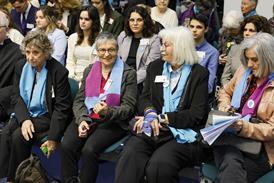Agreement on VHCCs does nothing to aid majority of criminal bar, let alone solicitors.
Reversing the landmark decision of HH Judge Leonard at Southwark Crown Court to kick out a fraud case in which none of the five defendants had advocates because of protests over legal aid cuts, the Court of Appeal instructed the bar and the Ministry of Justice to knock heads together.
Like a headmaster admonishing pupils, Sir Brian Leveson told them: ‘It is of fundamental importance that the MoJ, led by the lord chancellor, and the professions continue to try to resolve the impasse that presently stands in the way of the delivery of justice in the most complex of cases: this will require effort by both sides.’
A couple of weeks ago the defendants in the case were back at Southwark, this time with a full complement of lawyers. It was clear a deal had been struck.
The ministry had undoubtedly been in a fix – and faced the embarrassment of having a string of multi-million-pound fraud cases booted out.
It had set a market rate for the work, and the market had told it the rate was too low. Its initial solution to the problem, expanding the Public Defender Service, had not produced sufficient numbers to cover the cases.
Bar leaders and the ministry did what they were told and negotiated. The result - as claimed by the ministry - was individual settlements with the 40 or so barristers concerned, yet adding up to no more than originally budgeted.
It is hard to see how this works: why would the barristers go back if the rates had not increased? The ministry declined to provide details of the figures. The Criminal Bar Association was similarly tight-lipped.
In a statement to his troops, the association's chair Nigel Lithman QC said: ‘There will be those who want to know the nitty-gritty detail and sums involved.’ But he declined to let the cat (fat or otherwise) out of the bag.
‘Suffice it to say that the fees offered have been accepted by the individuals concerned' who have apparently 'signalled their content with the outcome negotiated on their behalf and consider these fees to be appropriate and acceptable'.
Despite the ministry’s protestations, rumour has it that some of the fees agreed are generous, tempting one set that does not usually do legal aid to accept a case.
The deal also secured a commitment from the MoJ to halt its expansion of the PDS , which currently stands at seven silks and 18 juniors. It is worth noting that the ministry always denied that the bar’s protest and the PDS expansion were linked.
It’s a remarkable coincidence then that the plans stopped when the learned counsel decided to play nice and go back to work.
Lithman told the CBA: ‘This is not a moment for triumphalism or celebration, other than the triumph of good sense and the celebration of the bar being restored to its even keel in this regard.’
He is right in one respect – it is not a moment for celebration. But his latter remark is open to debate. Has it really restored the bar to an even keel?
The deal, which applies only to seven cases in which counsel had declined to act, secured a promise of faster, larger interim payments for undertaking very high cost cases (VHCCs) and a future promise to reform the VHCC payment system.
Last year there were 12 VHCCs and they account for 0.1% of criminal legal aid work. The barristers involved are by definition at the top of their tree and, as one would expect, get by financially.
But the deal does nothing to help the majority of the criminal bar, junior barristers in particular, who are struggling to make ends meet and turning away from criminal work in droves.
And it does nothing, of course, to help solicitors, who are the backbone of the system, providing crucial initial advice in the police station.
Catherine Baksi is a Gazette reporter

















![David Lester (senior partner at Blythe Liggins), Darryl Barnes, Jagdeep Sandher (head of dispute resolution at Blythe Liggins)[4]](https://d1d8vslyhr7rdg.cloudfront.net/Pictures/274x183/4/2/8/116428_davidlesterseniorpartneratblytheligginsdarrylbarnesjagdeepsandherheadofdisputeresolutionatblytheliggins4_981603_crop.jpg)









1 Reader's comment